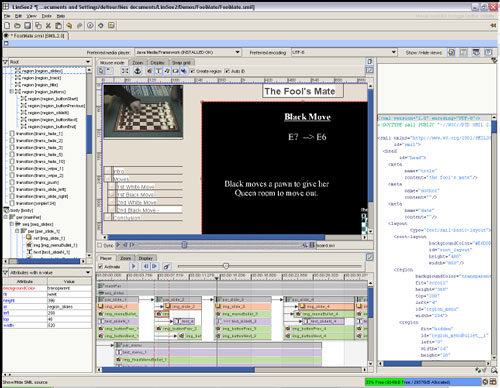|
|
 | | | < Contents ERCIM News No. 62, July 2005 | SPECIAL THEME: Multimedia Informatics | | | | LimSee2: A Cross-Platform SMIL Authoring Tool by Romain Deltour, Nabil Layaïda, and Daniel Weck
LimSee2 is an open-source and cross-platform authoring tool dedicated to the manipulation of time-based multimedia documents for the Web. It relies on the SMIL standard of the World Wide Web Consortium (W3C). With the rapid diversification of the Web (access devices, communication networks etc), the utilization of multimedia documents is becoming common practice. For this reason, in 1998 the W3C designed a standard mark-up language dedicated to the description and synchronization of multimedia content: the Synchronized Multimedia Integration Language (SMIL, pronounced ‘smile’). However, authoring multimedia information remains a real challenge, as the traditional WYSIWYG paradigm is difficult to apply in non-deterministic multimedia presentations involving rich user interaction. Taking such parameters into account, the Web Adaptation and Multimedia (WAM) team of INRIA has developed LimSee2, an authoring tool that provides a powerful graphical user interface designed to assist in the manipulation of time-based multimedia and thereby increase productivity. LimSee2 has a multi-view solution that renders the structure of the SMIL document at different levels during the authoring process: timing and synchronization, spatial layout, XML tree etc. The different views are synchronized (a modification in one view is immediately rendered in all the other views) and provide functionality that allows a user to manipulate and fine-tune a SMIL document without requiring a full knowledge of the language. Spatial View
The spatial layout of a SMIL document can be edited in LimSee2 in a 2D canvas, which constitutes a WYSIWYG environment for a fixed time in the temporal scenario. SMIL regions can be easily moved, resized or created in a few clicks, media content can be directly previewed (for images, texts and videos), and region z-indexes can be adjusted with an intuitive drag-and-drop mechanism. The 2D canvas also provides traditional features such as a zooming tool or a customizable snap grid. Timing View
Visualizing the temporal scenario of a document during the authoring process is one of the key challenges of multimedia authoring. To fulfil this requirement, LimSee2 features a timeline view: a temporal element is represented by a box, with its length standing for the duration of the element, and its position standing for the start-time of the element. An arrow linking two boxes then represents a synchronization relation. Hence, the user can easily and intuitively adjust media synchronization by moving and resizing the boxes in the timeline. Moreover, a cursor may be moved through the timeline in order to see in the spatial view the state of the multimedia presentation at a specific time. This is very useful for previewing the results of the synchronization. In addition to SMIL-specific features (for instance SMIL temporal containers represented as collapsible box containers) the timing view also provides a zooming tool and media preview ability.  | | The LimSee2 SMIL authoring tool. | | XML Features
As SMIL is an XML language, many well-established XML technologies are directly involved in LimSee2. First of all, the DTD-awareness of the application ensures the validity of the underlying SMIL document model (provided that it is modified within the Limsee2 GUI). Additionally, a built-in validator can check on demand the conformance of the document with SMIL 1.0 or 2.0 syntaxes, and allows the user to correct possible errors interactively. LimSee2 also features two XML-dedicated views: the Structure View, which renders the hierarchical structure of the SMIL document as a collapsible tree, and the Attributes View, which is a high-level DTD-aware attributes editor allowing fine-tuning of the presentation directly from the attributes values. As for the users who want to directly access the source of their SMIL documents, LimSee2 integrates an XML source editor. This features traditional syntax highlighting, pretty formatting, and incremental search and replace, and seamlessly synchronizes with the other views. Other Features
In addition to the major features described above, LimSee2 also provides the following: - the character encoding of documents is detected at opening and can be changed on-the-fly
- the LimSee2 interface has just been internationalized, and is available in English, French, and Japanese
- a native player (eg RealPlayer, Ambulant) can be launched from the application to externally visualize the edited document
- a ‘storing’ mechanism means entire SMIL presentations can be saved into a single directory (source, media content, linked documents), even for distant data accessed by HTTP
- slides can be automatically imported as JPG images from Microsoft PowerPoint or OpenOffice.org presentations
- a slideshow builder tool allows the creation in a few clicks of multimedia slideshow presentations, which synchronize a video/audio track, an interactive table of content, a navigation panel and imported slide images.
Collaboration and Perspectives
A new version of the application is under development. It will be more user-oriented, and will feature powerful authoring functionality such as template-based editions or reusable models of documents. In parallel, the WAM Team is cooperating closely with NRCD (National Rehabilitation Center for Persons with Disabilities, Japan) on accessibility features in LimSee2, in the context of a project aiming at establishing a natural disasters preparedness system. Project Details
The development of LimSee2 was initiated by the Web Adaptation and Multimedia research team at the French National Institute for Research in Computer Science and Control (INRIA), Grenoble, France.
The project started in October 2002. The first public release was made on the 13th June, 2003. The latest available version is 1.5.2 and was released on the 28th March, 2005. LimSee2 is developed with Java J2SE 1.4.2. It is currently available on Windows, Linux, and Mac OS X platforms. Links:
LimSee2 Home Page: http://wam.inrialpes.fr/software/limsee2/
WAM Team Home Page: http://wam.inrialpes.fr/
W3C Synchronized Multimedia Page: http://www.w3.org/AudioVideo/ Please contact:
Nabil Layaïda, Romain Deltour, WAM Team, INRIA, France.
Tel: +33 4 76 61 52 84, +33 4 76 61 52 18
E-mail: Nabil.Layaida inrialpes.fr, Romain.Deltour inrialpes.fr, Romain.Deltour inrialpes.fr inrialpes.fr | | | | 
|



